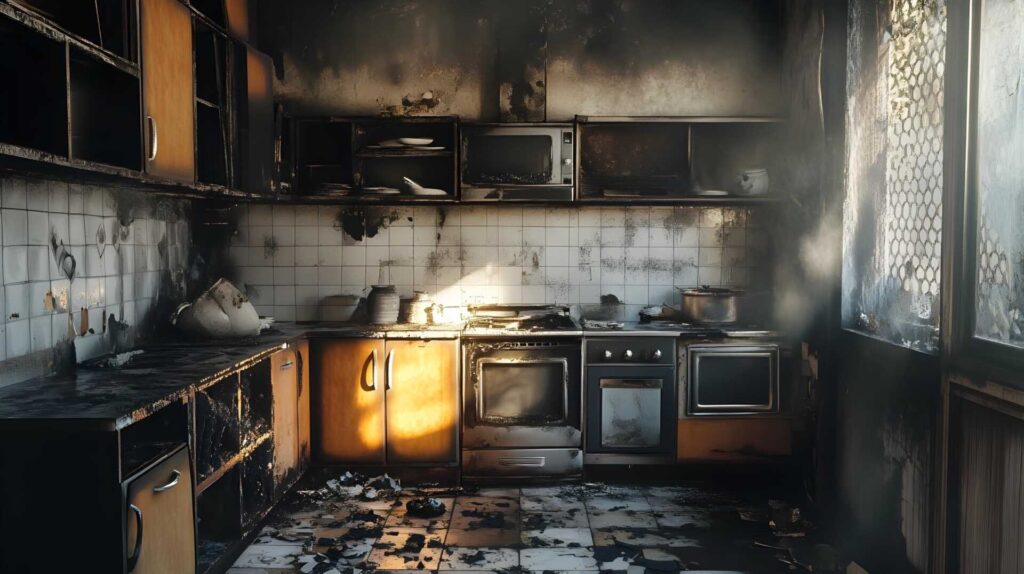
Contents
Imagine facing the aftermath of a fire in your home, unsure of where to begin the fire damage restoration process. As you navigate through the challenges of fire damage, understanding the top 7 expert tips can be your guiding light towards effective recovery. From gauging the severity of the damage to preventing future incidents, these tips encompass essential strategies to help you restore your home and peace of mind.
Key Takeaways
- Conduct a thorough damage assessment to understand the extent of fire damage.
- Utilize specialized cleaning products and equipment for effective restoration.
- Prioritize safety and health by focusing on air quality and sanitization.
- Consider fire-resistant materials and updates for future prevention.
- Engage with professionals and resources for comprehensive restoration guidance.
Assessing the Extent of Damage
When faced with fire damage, the initial step in the restoration process is evaluating the extent of the destruction. This critical stage involves conducting a thorough damage assessment to determine the impact of the fire on your property. From visible damage to hidden structural issues, a detailed evaluation is essential to outline the restoration plan effectively.
During the damage assessment, it’s crucial to document all the affected areas, including walls, ceilings, floors, and personal belongings. This detailed documentation won’t just help you understand the scope of the damage but also assist in filing insurance claims. Insurance coverage is an important aspect to bear in mind during the assessment process. Understanding your policy and its coverage for fire damage will guide you in making informed decisions regarding the restoration efforts.
Additionally, the damage assessment should also include an evaluation of any potential water damage caused by firefighting efforts. Water damage can worsen the destruction caused by the fire, leading to mold growth and structural issues if not addressed promptly.
Securing the Property
To properly initiate the fire damage restoration process, securing the property is essential. After a fire incident, ensuring property protection and implementing safety measures are key steps. Begin by evaluating the structural integrity of the building. Look for any signs of weakening, such as sagging ceilings or walls, which could pose a safety risk. If the structure is deemed unsafe, refrain from entering the premises until it has been inspected and declared secure by professionals.
Next, secure the property by boarding up windows, doors, and any other openings to prevent unauthorized access and further damage. This secures the property from potential intruders and also safeguards it from the elements. Covering openings also helps to contain any lingering odors and prevents animals from entering the premises.
Additionally, consider installing temporary fencing around the property to establish a clear boundary and enhance security. Make sure to prominently display warning signs indicating that the area is unsafe and off-limits. These safety measures protect individuals from harm and also reduce liability risks for property owners.
Removing Soot and Smoke Residue
To effectively address the aftermath of a fire incident, the initial focus must be on the meticulous process of removing soot and smoke residue from the affected property. This step is pivotal in preparing the space for further restoration and ensuring the safety of the individuals involved. Here are essential considerations for removing soot and smoke residue:
- Soot removal techniques: Utilize specialized cleaning methods such as dry sponges, wet cleaning, and HEPA vacuuming to effectively eliminate soot from surfaces. Different materials may require specific approaches to prevent further damage during the cleaning process.
- Smoke residue disposal: Properly dispose of smoke-damaged items and materials to prevent contamination or recontamination of the space. Segregate salvageable items from those beyond repair and ensure safe disposal practices in compliance with environmental regulations.
- Structural damage assessment: Conduct a thorough evaluation of the structural integrity of the property post-fire. Identify areas that require repair or replacement due to fire damage, including walls, ceilings, and flooring. Addressing structural issues promptly is essential for a successful restoration process.
Implementing these strategies with precision and care is critical in effectively removing soot and smoke residue, laying the foundation for the subsequent phases of fire damage restoration.
Deodorizing the Space
After successfully removing soot and smoke residue, the next vital step in fire damage restoration is deodorizing the space. Odor removal is crucial to make sure that the space isn’t just visually clean but also free from the lingering smell of smoke.
To effectively deodorize the area, start by ventilating the space by opening windows and using fans to allow fresh air to circulate. This will help disperse any remaining odors.
Air purification is another pivotal aspect of deodorizing after a fire. Consider using air purifiers with HEPA filters to help capture and eliminate odor-causing particles in the air. Additionally, ozone generators can be used by professionals to break down odors at a molecular level, effectively eliminating them from the environment.
For soft surfaces like carpets, curtains, and upholstery that may have absorbed smoke odors, thorough cleaning is necessary. Steam cleaning carpets and laundering curtains and upholstery with odor-eliminating detergents can help remove trapped odors.
In cases where the smell persists even after these efforts, professional restoration companies have access to specialized equipment and techniques for odor removal, such as thermal fogging or hydroxyl generators. These methods can effectively neutralize stubborn odors and restore the space to its pre-fire condition.
Cleaning and Sanitizing
For effective fire damage restoration, cleaning and sanitizing the affected areas is an essential step in ensuring the safety and health of the space. Utilizing proper restoration techniques and professional resources can make a significant difference in the outcome of the cleaning process.
When approaching the cleaning and sanitizing phase of fire damage restoration, keep the following key points in mind:
- Use Specialized Cleaning Products: Invest in professional-grade cleaning products specifically designed for fire damage restoration. These products are more effective in removing soot, smoke residue, and other contaminants from surfaces.
- Consider Hiring Professional Cleaners: In cases of severe fire damage, it’s highly recommended to enlist the services of professional restoration companies. These experts have the necessary experience, equipment, and knowledge to thoroughly clean and sanitize the affected areas.
- Focus on Air Quality: In addition to cleaning surfaces, pay attention to air quality. Utilize air scrubbers, ozone machines, and ventilation techniques to remove smoke odors and improve indoor air quality.
Restoring Damaged Items
When addressing fire damage restoration, the process of cleaning and sanitizing sets the foundation for a successful restoration outcome. Once these initial steps are completed, the focus shifts to restoring damaged items. Salvaging valuables and repairing furniture are vital aspects of this phase.
To salvage valuables, begin by carefully evaluating each item to determine if restoration is possible. Valuables such as jewelry, important documents, or sentimental items should be given priority. For items like clothing or fabric, professional dry cleaning services specializing in fire restoration may be necessary. Delicate items like artwork or antiques should be handled with extreme caution to avoid causing further damage.
Repairing furniture that has been damaged by fire involves thorough cleaning, deodorizing, and in some cases, refinishing. Upholstered furniture may need to be reupholstered, while wooden furniture might require sanding and refinishing to remove soot and smoke odor. It’s important to consult with restoration experts who’ve expertise in handling different types of furniture materials to secure the best outcome.
Preventing Future Fire Damage
To protect your property from potential fire damage, implementing proactive measures is vital. Consider the following expert tips to prevent future fire damage:
- Fireproofing Techniques
- Conduct a thorough inspection of your property to identify potential fire hazards such as faulty wiring, overloaded outlets, or flammable materials. Implement fireproofing techniques like using fire-resistant materials for construction and installing fire-resistant doors and windows.
- Safety Measures
- Install smoke detectors on every level of your home and make sure they’re in working condition by regularly testing them. Create a fire escape plan for your family with designated meeting points outside the house. Keep fire extinguishers in easily accessible areas and educate your family members on how to use them.
- Home Renovations
- Consider renovating your home with fire-resistant materials like fire-rated drywall and hardwood floors. Update your electrical system to meet current safety standards and avoid overloading circuits. Consult with a professional to confirm your home is up to code and safe from potential fire risks.
Remember to review your insurance coverage regularly to confirm you have adequate protection in case of a fire-related incident. By incorporating these fireproofing techniques, safety measures, and home renovations, you can greatly reduce the risk of future fire damage to your property.
Summary
Now that you’ve learned the top 7 expert fire damage restoration tips, you have the knowledge and tools to effectively address fire damage in your home. Following these steps ensues a thorough restoration process, prevents future incidents, and creates a safe living environment for you and your family. Remember, taking proactive measures and seeking professional help when needed are key to successfully restoring your property after a fire.
Recent Posts
What Are Eco-Friendly Water Damage Repair Methods?
When it comes to addressing water damage in an environmentally friendly manner, eco-conscious methods are
7 Best Eco-Friendly Water Damage Repair Methods
When faced with water damage, you must consider the environmental impact of your repair methods.
Sustainable Water Damage Repair Techniques: A How-To Guide
When faced with water damage in your home, it’s crucial to explore sustainable repair techniques
